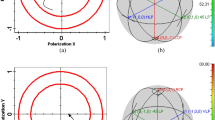Abstract
In this paper, the performance of wavelength division multiplexing based on free space optical communication is enhanced via the power comparative system (PCS). The proposed system is simulated by OptiSystem 7 and investigated under three main conditions, namely, without missig–pointing losses (MPL), with MPL and with MPL and PCS. In addition, three weather conditions are adopting in this work, namely, very clear, clear and hazy weather. According to the results, the MPL caused degradation in the maximum achieved link range to the ratio of 44.06%, 41.66% and 27.77% for the weather condition of very clear, clear and haze, respectively when compared with the system without MPL. While the achieved link range of the proposed system is enhanced when the PCS is employed by 45.45% for very clear weather, 42.85% for clear and 23.07% for hazy weather, when compared with the system with MPL. Furthermore, the performance of the proposed system is investigated and compared with the previous work under the same weather condition as well as compared with Kim model and show good agreement with it.












Similar content being viewed by others
References
Kumar, N., & Sohal, H. (2014). Impact of various weather condition on the performance of free space optical communication system. Journal of Optical Communications, 35(1), 45–49. https://doi.org/10.1515/joc-2013-0060.
Jain, D., & Mehra, R. (2017). Performance analysis of free space optical communication system for S, C and L band. In 2017 international conference on computer, communications and electronics, COMPTELIX 2017, pp. 183–189. https://doi.org/10.1109/COMPTELIX.2017.8003961
Shakthi Murugan, K. H., & Sumathi, M. (2019). Design and analysis of 5G optical communication system for various filtering operations using wireless optical transmission. Results Physics, 12, 460–468. https://doi.org/10.1016/j.rinp.2018.10.064.
Patnaik, B., & Sahu, P. K. (2012). Optimized hybrid optical communication system for first mile and last mile problem solution of today’s optical network. Procedia Technology, 6, 723–730. https://doi.org/10.1016/j.protcy.2012.10.087.
Esmail, M. A., Ragheb, A., Fathallah, H., & Alouini, M. S. (2017). Investigation and demonstration of high speed full-optical hybrid FSO/fiber communication system under light sand storm condition. IEEE Photonics Journal. https://doi.org/10.1109/JPHOT.2016.2641741.
Alnajjar, S. H., Ali, M. H., & Abass, A. K. (2019). Enhancing performance of hybrid FSO/fiber optic communication link utilizing multi-channel configuration. Journal Optics Communication. https://doi.org/10.1515/joc-2018-0193.
Aditi, P. (2014). An effort to design a power efficient, long reach WDM-FSO system. In 2014 international conference on signal propagation and computer technology,ICSPCT 2014 791 796 https://doi.org/10.1109/ICSPCT.2014.6885013
Grover, M., Singh, P., Kaur, P., & Madhu, C. (2017). Multibeam WDM-FSO system: an optimum solution for clear and hazy weather conditions. Wireless Personal Communications, 97(4), 5783–5795. https://doi.org/10.1007/s11277-017-4810-2.
M. A. Yaseen, A. K. Abass, and S. M. Abdulsatar (2020) Enhancing of multiwavelength free space optical communication system via optimizing the transceiver design parameters. Optical and Quantum Electronics. https://doi.org/10.1007/s11082-020-02498-z.
Fadhil, H. A., et al. (2013). Optimization of free space optics parameters: An optimum solution for bad weather conditions. Optik (Stuttg), 124(19), 3969–3973. https://doi.org/10.1016/j.ijleo.2012.11.059.
Kaushal, H., Jain, V. K., & Kar, S. (2017). Free space optical communication. Delhi: Springer.
Vitasek, J. Leitgeb, E., David, T., Latal, J., and Hejduk, S. (2014). Misalignment loss of free space optic link. In International conference on transparent optical networks, vol 2(2), pp 2–6https://doi.org/10.1109/ICTON.2014.6876494
Author information
Authors and Affiliations
Corresponding author
Additional information
Publisher's Note
Springer Nature remains neutral with regard to jurisdictional claims in published maps and institutional affiliations.
Rights and permissions
About this article
Cite this article
Yaseen, M.A., Abass, A.K. & Abdulsatar, S.M. Improving of Wavelength Division Multiplexing Based on Free Space Optical Communication via Power Comparative System. Wireless Pers Commun 119, 381–391 (2021). https://doi.org/10.1007/s11277-021-08216-6
Accepted:
Published:
Issue Date:
DOI: https://doi.org/10.1007/s11277-021-08216-6




